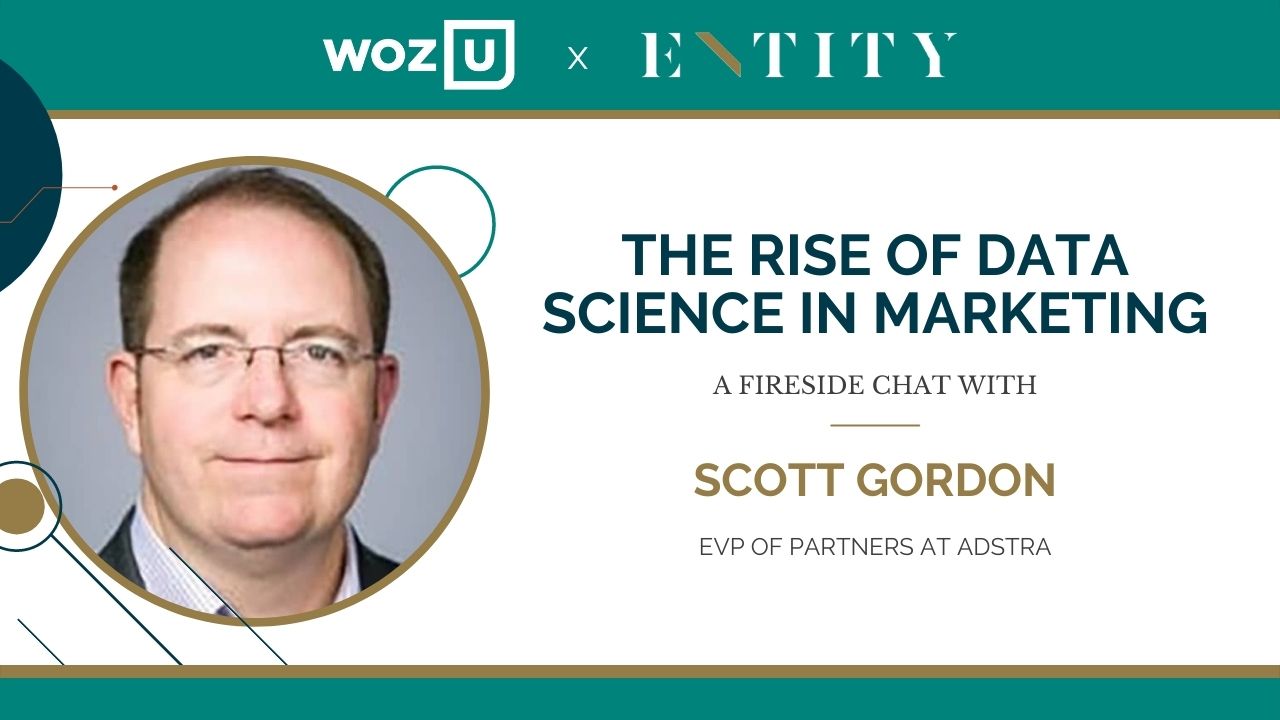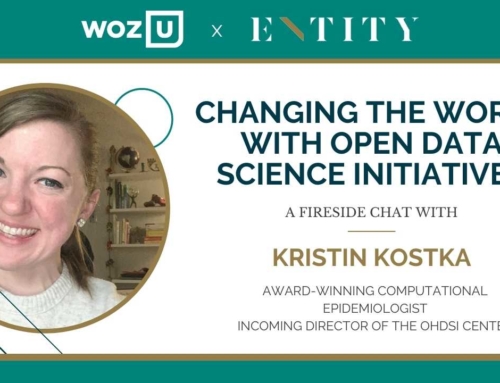Data has forever changed the way marketers reach consumers. Scott Gordon, SVP of Partners at data company Adstra, discusses these industry-wide paradigm shifts, how they impact consumers, where talented data scientists can make the biggest impact, and where he thinks emerging technologies will take marketing in the years to come.
Who is Scott Gordon?
Scott Gordon is the SVP of partners at Adstra, where he leads teams focused on the intersection of cross-channel digital advertising, marketing technology, and big data. In his words, he “Enables brands and big tech companies to better understand consumers” through data. A third-generation salesperson, Gordon set himself apart by understanding data and emerging marketing technology (abbreviated to “adtech”) to keep pace with the rapidly-changing landscape of digital advertising.
The New Digital Marketing Landscape
Data has completely revolutionized the way marketers and brands interact with consumers. Gone are the days of Don Draper-like “Mad Men” cooking up creative jingles to sell products. Authority Labs boils this shift down to one key element: precision. Where advertisers once relied on past campaigns and subjective opinions to create marketing strategies, data now supplies mathematical “evidence” of what’s working—or not. With data, advertisers can gauge what drives their target audience and, “Better measure the impact and effectiveness of their marketing spend.”
Gordon notes that one of the key takeaways brands and agencies have gleaned from data is how to best communicate with their audience. He shared, “We’ve proven through previous campaigns that you need multi-touch. You need to hit people with a softer message. People want to feel like they’re engaged and having a conversation with a brand to some extent, and technology is the only thing that’s going to enable that in a real capacity.” Multi-touch attribution involves exposing potential customers to your brand numerous times through multiple channels, including a social media ad, a pop-up on a website, or a promotional email. Data informs every step of this model, allowing companies to maximize their marketing dollars to boost sales or brand awareness.
The COVID-19 pandemic has accelerated the need for businesses to refine how they engage with their customers. “Industry-wide, advertisers pulled back because they needed to learn how to communicate with their consumers again. They needed to change their messaging,” Gordon explained, citing new commercial rollouts with actors wearing face masks as a general example of brands’ new approach. Additionally, a move towards a direct-to-consumer (D2C) business model was already taking place, but the pandemic hastened this shift as companies sought to reach customers in new ways. Data scientists who understand how to contextualize, source, and best utilize consumer data will be essential in this D2C transition.
“They need data scientists and data to work with, and the tools to utilize to take best advantage of that data set,” said Gordon.
The Role of AI
Gordon cites Artificial Intelligence and machine learning as one of the biggest facilitators of these industry-wide shifts in strategy. With the rise of smart devices and social media comes countless new data points and identity signals, and AI has emerged in tandem as a helpful tool to process that raw data. Gordon highlighted speed as AI’s main appeal to marketers, explaining, “With AI and machine learning, you have the ability to ingest significantly more data sets to keep up with technology. If we didn’t have AI, we wouldn’t be able to ingest all the data sets that are coming in and make real-time decisions that could impact campaigns.”
This real-time engagement includes the now-ubiquitous conversational AI chatbots that often appear as users peruse a website. The AI’s ability to communicate like a human customer service representative is crucial to that feeling of “conversing with a brand” that Gordon previously mentioned. The chatbot’s ability to prospect and increase lead generation, reach customers faster, and provide round-the-clock support are just some of the many benefits of utilizing this new tech, which is why Digital Skills Global estimates that over 85% of customer service centers will operate using AI within the next 5 years.
Gordon predicted that the influence of Artificial Intelligence in advertising will only continue to grow. “It’s very much a ‘Minority Report’ kind of moment: someone is walking and they do an action, and suddenly the advertising is adapting to that action. We’re not there yet, but we see digital out-of-home and the growth there is really exciting.”
This emerging “digital out-of-home” marketing strategy refers to electronic billboards and interactive screens in shopping malls and other public places. These are some of the most effective and engaging modern advertising tools, but the trick is not to overexpose existing customers and waste marketing spend. That’s where data science comes in to make every pixel and penny count.
Hey Siri! Are You Listening?
Gordon’s lighthearted “Minority Report” reference brings up an unnerving question on many consumers’ minds: how much data do companies have about us, and what are they doing with it?
Sometimes targeted ads are so accurate it almost feels like our smart devices are “listening” to us. When asked about this eerie phenomenon, and whether or not our devices are actually “listening,” Gordon said, “Sometimes it would appear that way. I think more often than not it’s that psychological effect of ‘I bought a Jeep and suddenly I see Jeeps everywhere.’”
He then went on to add, “There are certain times where there is connective tissue,” and detailed how some ads target consumers more broadly than on the individual level. “In some cases, you could actually be receiving an offer that your neighbor looked up because some of these [ads] are not targeted at the individual or household level. They’re a little broader.” So the next time you see a McDonald’s ad just when you were craving it, perhaps your neighbor is to blame.
The process behind this targeting technology is more straightforward than you would think. Gordon debunked how walled gardens operate—self-contained digital ecosystems that collect but do not share information—and listed the multiple signals these organizations use to aggregate data: IP addresses, cookies, mobile IDs, and some direct mail components. Brands acquire this data as you engage with them, but where many consumers feel uneasy is the next step, when that data is processed and used for marketing. A Pew Research Center survey found that 79% of Americans are either somewhat or very concerned about how companies use their data, and 81% feel they don’t even have control over what data is collected.
Gordon understands these fears and underscores the user’s ability to opt-out as surefire protection against unwanted data collection. In fact, recent innovations in the industry make your data more secure than ever.
“You used to opt-out on a browser and only be opted-out on that machine and that browser. If you deleted that cookie your opt-out disappeared,” Gordon explained, meaning that deletion essentially reversed your decision and automatically opted you back in for data collection. Nowadays, consumers can opt-out at the personal level, ensuring that no company can collect or sell their data unless they opt-in again.
Consumer Rights and Data Privacy
What used to be a “wild west” of data collection is now becoming increasingly regulated, which Gordon welcomes after years of working in the adtech space. Some new protocols include robust privacy standards such as the California Consumer Privacy Act (CCPA), which Adstra has implemented on all its products and services nationwide. This grants consumers more control over who collects their data and how it is utilized. Gordon admits these are not “perfect fixes,” but overall views these changes as positive steps in the right direction. “There’s always a path forward…It’s good to be cautious and respectful of the data and the data rights of consumers, but it doesn’t mean you can’t do anything with the data. It just means you have to follow the right protocols to do it.”Stricter privacy laws don’t always spell bad news for advertisers. Gordon remarked, “The move for privacy and the move for ownership of data actually creates greater strength within the walled gardens—the Facebooks, Amazons, Googles of the world—where they’re restricted now from sharing data in any capacity.” As a result, data companies are “rushing” to create consumer-level unified IDs to consolidate the influx of third-party data and better exchange it with fellow participants in the adtech space. “At some point, they’re going to have to consolidate to a handful that makes sense for the consumer,” Gordon predicts, but for now there are several on the market for advertisers to choose from.
The key to assuaging consumers’ fears and helping marketers utilize their data ethically and effectively is education, Gordon concluded. A positive result of this new call for privacy rights is that “consumers are much more aware of what’s going on in the background.” With this newfound awareness comes change, something Gordon says is a constant in the industry.
The Future of Data Science in Data Marketing
As advertisers come to rely on data in all aspects of their marketing funnels, there is an increasing demand for data scientists to help make sense of this influx of information.
“The cost for data—not only the data itself but the infrastructure to run the data—has dropped tremendously,” Gordon explained. This enables more and more companies to afford to bring in data sets and upsize their marketing efforts. With the transition to direct-to-consumer business models and the implementation of Artificial Intelligence, there are countless avenues where data scientists will prove essential to marketing efforts.
As a marketer with a deep understanding of data, Gordon championed data scientists as “the new rockstars” of the advertising world, sharing, “The best data scientists that I’ve seen aren’t just pure-play data scientists. They understand context, they understand how to communicate with clients and their own colleagues. They understand how to suss out what the real challenge is—they get away from the numbers.” Developing soft communication skills as well as hard technical know-how will give future data scientists a leg up as they enter any industry, but especially in adtech.
Gordon doesn’t see this rise of data science in marketing slowing down anytime soon. “Everything is pushing towards the algorithmic utilization of data,” he shared. If you have a passion for marketing and an understanding of data, the pool of brands and organizations seeking talents with these skills only continues to grow. “There is so much opportunity in this space both from a professional level and in the industry at large.”

Abby Alben
Abby Alben is a Los Angeles-based writer and the Digital Media & Marketing Coordinator at ENTITY Academy. She earned a B.A. in English from UCLA in 2020 and has worked for a number of collegiate news and lifestyle publications, including the Daily Bruin.




